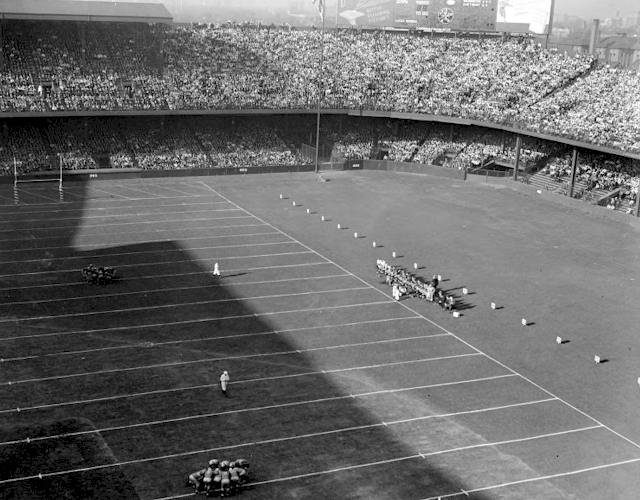
The Detroit Lions play a home game at Briggs Stadium in the late 1930s.
Detroit Lions fans are no stranger to defeat.
Use whatever adjectives you wish to describe the team’s losses throughout the decades.
Bizarre.
Inexcusable.
Gut-wrenching.
Why should it not be surprising that the Lions suffered a loss in their first game ever at old Briggs Stadium? The outcome was typical, a classic example of the blundering execution that has plagued this franchise seemingly forever.
The date was October 16, 1938. First, a little background.
The Lions began as the Portsmouth (Ohio) Spartans, but moved to the Motor City in time for the 1935 NFL season. They won the championship that first year under head coach Potsy Clark, but since then had failed to make the playoffs.
They played those first three years at the University of Detroit’s old football stadium, which had a capacity of roughly 23,000. The Lions drew well; Green Bay and Chicago were sellouts in 1937, while the other contests on the home schedule drew near-capacity crowds.
The Lions, understandably, began looking for a larger venue closer to downtown.
At that point, Tigers owner Walter O. Briggs entered the picture. His team had gone to the World Series in 1934 and ’35, while playing in tiny Navin Field. After winning the Series in ’35 and raking in the cash from the construction of temporary post-season bleachers, Briggs knew the ballpark at Michigan and Trumbull could use an expansion.
Briggs began the process of transforming Navin Field into the 55,000-seat stadium that generations of Tiger fans would later know and love. He called the place Briggs Stadium. It was now a premier sports venue, and the Lions took note.
In March 1938, the Lions and Tigers agreed to a deal in which the football team would play six games at Briggs Stadium the upcoming season. Spike Briggs, the son of Walter and treasurer of the Lions, negotiated the contract.
The Lions’ home opener, on September 9, 1938, a 16-7 win over the Pittsburgh Pirates, was the last game they played at U of D Stadium.
Two road contests followed; a win over the Cleveland Rams and a loss at Green Bay.
A new Lions era dawned the following week. The Washington Redskins, reigning NFL champions, were in town for a 2 p.m. start. Reserved seats, which went for $1.10 and $2.20, were sold out in advance. Fans formed long lines to gobble up the day-of-game general admission tickets for 55 cents.
The final tally showed 42,850 Lions rooters in attendance on that unseasonably hot day. At the time, it was the largest crowd ever to witness a football game in Detroit. The Wayne University marching band (the school would change its name to Wayne State in 1956) played both before the game and at halftime. The Detroit Free Press hailed it at the time as “the best college band in America.”
Detroit took a 5-0, first-quarter lead, courtesy of a 30-yard field goal and a safety. In the third quarter, however, the Lions found a way to lose. Redskins tackle Wee Willie Wilkin (who was not wee at all at 6’ 4” and 261 pounds) blocked a Lions punt by Vernon Huffman. A scramble ensued, with the ball rolling out of bounds at the Detroit 17-yard line. Washington was given possession.
A couple of nice runs by the Redskins’ George “Automatic” Karamatic and Andy Farkas (a former U of D player), brought the ball to the seven. On third down, wrote the Free Press, “Farkas skimmed over the top of a milling heap of fighting lineman” for a touchdown. Riley Smith kicked the extra point.
And that was the ball game. A Lions loss, but the team’s first day at Briggs Stadium was, in the words of the Free Press, “a brilliant spectacle.”
The defeat dropped Detroit into third-place in the Western Division behind the front-running Chicago Bears and the Packers. Washington, meanwhile, stayed on top of the Eastern Division, just ahead of the New York Giants.
By season’s end, neither Detroit nor the Redskins qualified for the playoffs.


